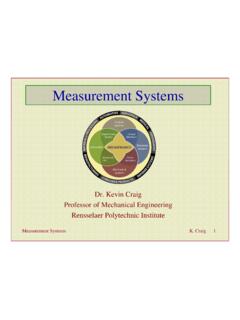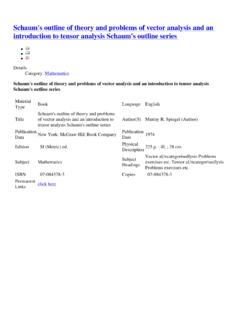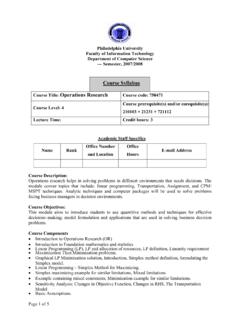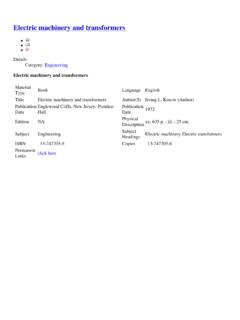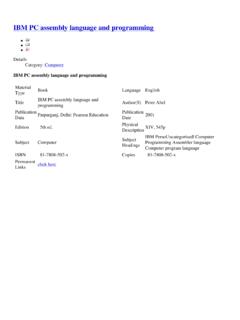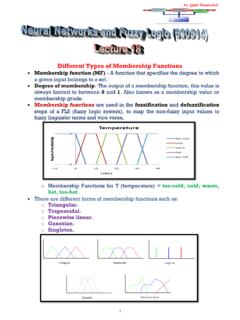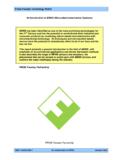Transcription of Research Methodology Part III: Thesis Proposal
1 Research Methodology Part III: Thesis Proposal Dr. Tarek A. Tutunji Mechatronics Engineering Department Philadelphia University - Jordan Outline Thesis Phases Thesis Proposal Sections Thesis Flow Chart Dr. Tarek A. Tutunji 2 Thesis Phases the Research title the Research the Research the Research / Thesis Dr. Tarek A. Tutunji 3 Thesis Phases the Research title the Research the Research the Research / Thesis Dr. Tarek A. Tutunji 4 Thesis Proposal Thesis Phases the Research title the Research the Research the Research / Thesis Dr. Tarek A. Tutunji 5 Thesis Proposal Thesis Thesis Phases the Research Title Choose an advisor for your Thesis work Initiate Research problem Do initial literature review Define Research problem Propose title Submit the Thesis Title document Dr.
2 Tarek A. Tutunji 6 Thesis Phases the Research Do comprehensive literature review Focus the Research problem Propose Research Methodology Specify models and/or algorithms to use Specify equipment to use Specify data-gathering technique Specify evaluation technique Identify originality and significance of your work Identify the objectives and expected outcomes Show the Research -work time-line Submit the Thesis Proposal document Dr. Tarek A. Tutunji 7 Thesis Phases the Research Develop / derive any needed theoretical work such as: Models Methods Algorithms Apply the developed models and methods using simulation and/or experiments Collect data Analyze results Validate your work Dr.
3 Tarek A. Tutunji 8 Thesis Phases the Research / Thesis Extend the Research Proposal Write an abstract Add to the literature review Modify existing sections Document any theoretical work Present the Research results, such as data Analyze and validate results Write the conclusion Write and revise the Thesis Submit your Thesis Dr. Tarek A. Tutunji 9 Thesis Proposal Sections Review background Plan and Future Work References Dr. Tarek A. Tutunji 10 Abstract Abstract is a concise and direct one-paragraph that describes the contents of the article. It should be an overview of the most important elements of the article: Objective Methodology Results Conclusion Note: Abstract is part of the Thesis (not the Thesis Proposal ) Dr.
4 Tarek A. Tutunji 11 Abstract Example This paper presents a method to identify and control electro-pneumatic servo drives in a real-time environment. Acquiring the system s transfer function accurately can be difficult for nonlinear systems. Therefore, a Mixed-Reality Environment (MRE) is employed to identify the transfer function of the system using a Recursive Least Squares (RLS) algorithm based on the Auto-Regressive Moving-Average (ARMA) model. On-line system identification can be conducted effectively and efficiently using the proposed method. The advantages of the proposed method include high accuracy in the identified system , low cost, and time reduction in tuning the controller parameters. Furthermore, the proposed method allows for on-line system control using different control schemes.
5 The results, obtained from the on-line experimental measured data, are compared to the identified transfer function and show that the proposed Methodology is able to estimate and control system behavior. Dr. Tarek A. Tutunji 12 Objective Methodology Results / Conclusions Saleem, Abd Rabbo, and Tutunji, On-line identification and control of pneumatic servo drives via a mixed-reality environment , International Journal of Adv. Manufacturing Technology, 2008 Introduction Summary of the Research question Motivations why it is important Problem in general Focus to your Research statement Write your hypothesis State your Thesis statement Identify objectives Identify originality Identify significance List expected outcomes Dr.
6 Tarek A. Tutunji 13 Introduction Example Unmanned Aerial Vehicles (UAV) are becoming very attractive for the civil applications such as forest fire detection, traffic surveillance, rescue missions, environment monitoring, and agricultural spraying. Interest for Research in the UAV has been increased by the recent achievement in micro electromechanical Systems ( mems ), power storage, microcontrollers, communications, electronics miniaturization, automation and control. The UAV can be grouped in two main categories: Fixed wings and rotary wing. One of the most used rotary wings vehicle is the quad-rotor. Compared with fixed wings aerial vehicle, the quad-rotor has several advantages such as: Vertical take-off and landing, hovering capabilities, flying at a lower speed, and high maneuverability in restricted area.
7 Dr. Tarek A. Tutunji 14 Stanculeanu and Borangiu Quadrotor. Black-Box system Identification , World of Science, Engineering, and Technology, Vol 5, 2011 Introduction Example However, quad-rotors are difficult to control because of their unstable and high coupled dynamic system and unstability. Therefore, there is an interest in developing mathematical models using system identification. The most commonly-used methods for modeling quad-rotors are based on Newton-Euler and Euler-Lagrange models. However, these dynamic models use the forces and moments as inputs. The work in this paper is focused on using Multi-Input Multi-Output (MIMO) identification for quad-rotors using motor commands as inputs.
8 Dr. Tarek A. Tutunji 15 Literature Review Review Survey of what others did Synthesis their work Identify gaps Position your Research Dr. Tarek A. Tutunji 16 Literature Review Example Hardware-in-the-loop (HIL) simulation enables the operation and testing of actual components of a system along with virtual computer-based simulation models of the rest of the system in real time [1,2]. In a typical HIL test, the hardware component consists of a box of electronic components which can communicate with the software models via electrical signals exchanged using a data acquisition card [3]. Several studies have been reported for the use of HIL simulation approach for rapid prototyping of electronic control unit (ECU) of turbojet [4 6] and turbofan engines [7 9].
9 Recently, the use of HIL simulation to test the mechanical and other components has been attracted. Such simulations which have significant power flows between the real hardware and simulation make their design more challenging. This kind of HIL simulation is often called actuator-based HIL simulation or dynamic substructuring. Gawthrop et al. [3,10] presented an overview to the topic of real-time dynamic substructuring in variety of applications. Dr. Tarek A. Tutunji 17 Montazeri-Gh et al, Actuator-based hardware-in-the-loop testing of a jet engine fuel control unit in flight conditions . SIMPAT 2012 Literature Review Example In the field of aerospace engineering, several researches have been undertaken to employ the concept of the HIL simulation to examine the performance of aircraft vehicle components within a closed loop virtual simulation of the remaining subsystems.
10 For instance, the authors in [11] have presented the development of an HIL simulation for testing of vision based control systems for unmanned aircraft vehicles (UAVs). The authors have explained how to integrate a camera-in-the-loop simulation with the model aircraft in a wind tunnel. In addition, the study reported in [12] has addressed the testing of electro- hydraulic actuators and their interactions with the representative environment by emulating the aerodynamic loads caused by the aircraft control surfaces. In [13], a study of the performance of a fuel-cell-powered UAV using an HIL simulation of the aircraft in flight has been presented. The authors of [14,15] have presented an integrated flight control development to implement and test the flight controllers on small unmanned aircraft vehicle systems.
